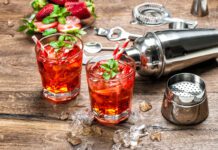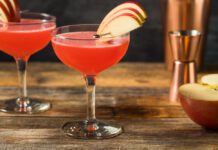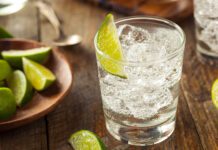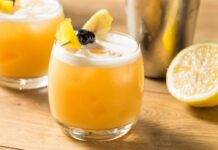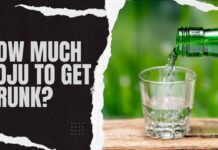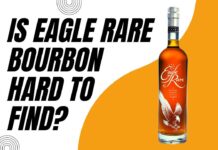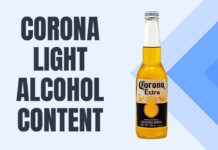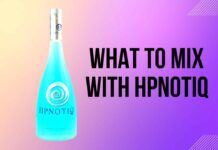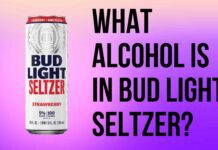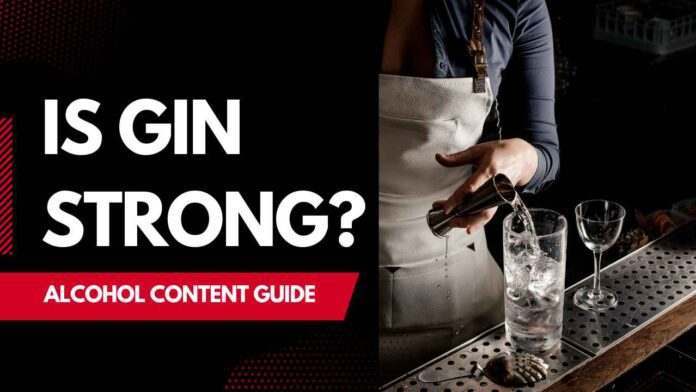This page may contain affiliate links. Please see our Disclaimer for more information. Always drink responsibly and adhere to your local legal drinking age.
Have you ever wondered if gin is stronger than other types of alcohol? If so, you’re not alone. Many people are curious about the alcohol content of gin, or “proof” as it is often referred to, and want to know exactly how strong it is.
The answer to this question isn’t simple and can vary greatly depending on the type of gin you drink and its proof level. All gins do not fall into one specific proof category, so you should know the differences before deciding which one to try.
In this article, we’ll look at gin’s alcohol content so that you can decide which type might be best for you. We’ll also discuss choosing a high- or low-proof version to suit your preferences. Let’s get started!
Is Gin Strong?
Are you wondering if gin is strong? The answer might surprise you—gin is not especially strong compared to other liquors.
Gin typically has an alcohol content between 35%-50%. One regular serving would be between 12-14 grams of pure alcohol. To put this into perspective, one serving of vodka contains 40% alcohol, and the same serving of whiskey contains 55% alcohol.
Knowing that gin is not as strong as other hard liquors, you can decide if it’s the right spirit for you. Remember that while gin may not be considered a “strong” liquor, it can still cause intoxication, depending on how much you drink. If you plan on consuming gin, remember to do so in moderation and always with food.
How Much Alcohol Is in Gin?
The strength of gin can vary greatly—so it’s hard to answer the question “is gin strong” without more context. Generally, gin is an 80-proof spirit containing 40% alcohol by volume (ABV). That’s slightly less than vodka, which has a higher ABV of 40%-50%.
However, that doesn’t mean all gins are created equal! Many craft gins tend to be bottled at a higher ABV and can range anywhere from 82-120 proof. Certain varieties like Navy Strength or Overproof gins can be even stronger than average, typically ranging from 114-124 proof.
But despite this wide range of alcoholic content, the key to drinking gin safely lies in moderating your consumption. Stick to the recommended serving size per glass (1.5 ounces for an 80-proof gin), and you’ll be ready!
Types of Gin & Strength Variations
Gin is interesting because your chosen type will greatly affect its alcohol content. For example, regular gin is typically between 37% and 40% ABV, while a London dry gin can range from 37% to 50%, and some craft gins go as high as 70%.
Navy Strength Gin
At the top of the ladder is navy strength gin, which it’s famously strong—it must clock in at 57% ABV or higher. It’s got a big flavor, and it can add a kick to cocktails when you use it as an ingredient.
Flavored Gins
On the other end of the spectrum are flavored gins. These have a lower alcohol content because additional ingredients have been added that bump down the ABV measurement. For example, many flavored gins range from 30-40%.
In general, gin is usually categorized into three groups: 1) juniper-forward styles, 2) modern (citrus-forward), and 3) Old Tom — which has a hint of sweetness due to sugar added after distillation.
It all depends on your preferences; whatever type of gin you choose, it’s important to be mindful of how much alcohol you consume to enjoy your drink in moderation.
ABV – Alcohol by Volume
So, is gin strong? The short answer is yes! Gin typically has an ABV (Alcohol by Volume) of 37.5% to 50% or even higher. To put that into perspective, beer typically has an ABV of between 2 and 12%. So yes, gin is strong!
The ABV level for gin varies between brands and craft producers. For example, Bombay Sapphire captures the essence of 10 unique botanicals and is distilled at 94.6%. There are also special gins with higher ABVs, like Blooming Gin with 40% ABV, Portabello Road Gin with 41.3%, or Tanqueray No. Ten with 47%.
So while it may not be as strong as other spirits like whiskey, rum, or tequila—gin still packs a punch when it comes to alcohol content!
What Affects the Strength of Gin?
When it comes to the strength of gin, a few factors come into play. So let’s look at those next.
Proof
One of the main determinants of how strong your gin is is proof. The proof is used to measure alcoholic beverages, and it’s twice the percentage of alcohol by volume (ABV). For example, if a bottle of gin is 40% ABV, then its proof would be 80. This means 80-proof gin has 40% ABV, and 110-proof gin has 55% ABV.
Ingredients
Another factor that affects a gin’s strength is its ingredients, wildly depending on the distillery or brand and what they put in it. Each type has different levels of juniper berries which are high in natural oils, which can provide a lot of flavors but also make it stronger. Some have citrus or herbs added to complement the flavor profile—the more you add, the stronger your gin gets!
Serving size
Last is serving size, which depends on how much you pour and how strong you want your drink to be. Gin martinis and other mixed drinks are generally one to two ounces (30-60mL), while shots are generally 1-1/2 ounces (45mL). The higher the proof you use for your drink, the less alcohol there will be per ounce—so if you’re looking for a stronger drink, use lower-proof gins!
Understanding the ‘Proof’ Measurement
Gin is certainly strong regarding the alcohol content, and understanding the ‘proof’ measurement is essential to know just how strong.
British sailors originally used the proof measurement to ensure they got their fair share of booze on board. They would mix their rum with gunpowder and then light it. If it burned, they knew the rum was proof enough (enough alcohol content). Nowadays, a drink’s ‘proof’ in America is twice its percentage of alcohol by volume. So if a gin has 40% alcohol by volume (ABV), its proof is 80 ‘proof.’
If you’re drinking gin, you can expect an ABV between 37-50% and a ‘proof’ between 74-100. For example, London Dry Gin, one of the most popular styles of gin, has around 47-50% ABV or 94-100 ‘proof.’ For comparison, Vodka has around 40% ABV or 80 ‘proof.’
It’s also worth noting that many super-premium gins are stronger than vodka — coming in at 45-50% ABV or as high as 90–100 ‘proof.’ So if you’re looking for something strong that packs a punch, look no further than gin!
Alcohol Content of Gin vs. Other Spirits
No doubt you’ve heard: gin is strong. But it’s not as strong as you might think—unlike other spirits. Gin can have 37.5 and 50 percent alcohol by volume (ABV). That’s less than other spirits, like tequila and whisky, which typically clock in at around 40 to 80 percent ABV.
So why is gin so popular if it’s “weak” compared to other spirits? Let’s break it down:
- Gin has a flavourful juniper base that makes it popular for mixing into cocktails or sipping neat
- With the right mixer, its flavor can be toned down while still lending its unmistakable notes to any drink
- Gin is easy-going, making it an ideal drink for socializing and having a good time
Whether your preference is neat or with a mixer, the lower ABV of gin can be a good thing—it lets you enjoy the flavor without worrying about the inevitable next-day hangover!
Health Considerations When Drinking Gin
Gin is a strong drink, no matter how you look at it. Its alcohol content varies slightly but usually contains between 37.5 and 50% ABV (alcohol by volume). That’s why it’s important to be aware of the health considerations of drinking it.
Moderation is Key
Gin can be enjoyed responsibly, but like any alcoholic beverage, it should be consumed in moderation. The general recommendation is up to 3 drinks per day for men and 2 drinks per day for women. It’s also important to note that one standard drink of gin (1.5 ounces) contains about 14 grams of pure alcohol – that’s approximately what you’d find in an 8-ounce bottle of beer!
Potential Health Risks Associated with Overconsumption
Alcohol abuse has been linked to several health risks, including liver disease and certain types of cancer, and can even increase your risk for heart disease and stroke. It can also affect your mental health, leading to depression and anxiety.
When considering drinking gin regularly or in larger amounts, it’s important to consider these factors and the recommendations regarding moderation above. It may take time and practice to build healthy habits; as such, if you find yourself needing help with alcohol consumption or addiction, please seek out professional help immediately.
Popular Gin Brands
So, is gin strong? Well, it all depends on which gin you’re drinking. Common brands of gin like Tanqueray and Beefeater, have an alcohol content of 47.3%. Popular brands like Bombay Sapphire and Hendrick’s Gin have a higher alcohol content of around 50%.
Here is a quick breakdown of the most popular brands to give you an idea of the strength of each one:
- Tanqueray: 47.3%
- Beefeater: 47.3%
- Bombay Sapphire: 50%
- Hendrick’s Gin: 44%
- Pinnacle Vodka: 40%
- Gordon’s Gin: 37.5%
It’s important to be mindful when drinking any rated spirit, whether gin or hard liquor. Remember to enjoy in moderation and drink responsibly!
Gin Cocktails
FAQ
You may still be unclear about just how strong gin is. The answer to that depends on how much you drink and which type of gin you have.
London Dry Gin
London dry gin is one of the best-known types, and it typically has an alcohol content range of 37.5%-50%, but some brands can go up as high as 57%. The higher end of that range is where you’re getting a significant hit, so if you’re looking for a powerful drink, London dry gin might be it.
Old Tom Gin
Old Tom gin usually has an alcohol content of around 41-47%, slightly lower than London dry. It’s also slightly sweeter, and the hint of licorice flavor is the most noticeable addition. So if you want something with a little less kick, Old Tom might be right up your alley.
Flavored Gin
Flavored gins come in all sorts of varieties — raspberry, elderflower, cucumber — and many are infused with liqueurs or juices that are lower in alcohol content, bringing the gin’s overall alcohol content down too (as low as 20%). That’s very different from London dry or Old Tom gins, where the alcohol content is much higher.
Conclusion
So there you have it. Gin is a complex spirit that can range from low to high in alcohol content. The proof, ABV, and calorie count can all vary depending on the brand and type of gin. It can be enjoyed neat, mixed in cocktails, or even as the base of a spritzer.
It may be strong, but it’s also incredibly popular, thanks to its refreshing and unique flavor. The next time you wonder, “is gin strong?” think about not just the alcohol content but also the variety of ways you can enjoy it.


